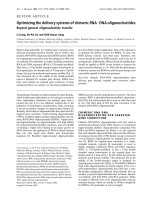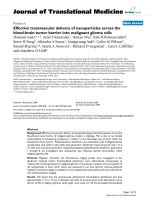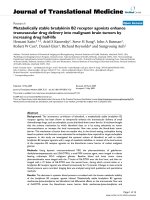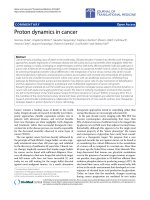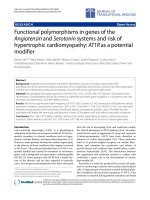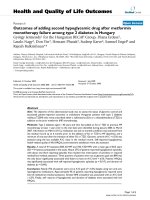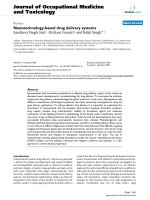Báo cáo hóa học: " Nanotechnology-based drug delivery systems" pdf
Bạn đang xem bản rút gọn của tài liệu. Xem và tải ngay bản đầy đủ của tài liệu tại đây (241.61 KB, 6 trang )
BioMed Central
Page 1 of 6
(page number not for citation purposes)
Journal of Occupational Medicine
and Toxicology
Open Access
Review
Nanotechnology-based drug delivery systems
Sarabjeet Singh Suri
1
, Hicham Fenniri
2
and Baljit Singh*
1
Address:
1
Department of Veterinary Biomedical Sciences and Immunology Research Group, University of Saskatchewan, 52 Campus Drive,
Saskatoon, SK, S7N 5B4, Canada and
2
National Institute of Nanotechnology, National Research Council (NINT-NRC) and Department of
Chemistry, University of Alberta, 11421 Saskatchewan Drive, Edmonton, AB, T6G 2M9, Canada
Email: Sarabjeet Singh Suri - ; Hicham Fenniri - ; Baljit Singh* -
* Corresponding author
Abstract
Nanoparticles hold tremendous potential as an effective drug delivery system. In this review we
discussed recent developments in nanotechnology for drug delivery. To overcome the problems
of gene and drug delivery, nanotechnology has gained interest in recent years. Nanosystems with
different compositions and biological properties have been extensively investigated for drug and
gene delivery applications. To achieve efficient drug delivery it is important to understand the
interactions of nanomaterials with the biological environment, targeting cell-surface receptors,
drug release, multiple drug administration, stability of therapeutic agents and molecular
mechanisms of cell signalling involved in pathobiology of the disease under consideration. Several
anti-cancer drugs including paclitaxel, doxorubicin, 5-fluorouracil and dexamethasone have been
successfully formulated using nanomaterials. Quantom dots, chitosan, Polylactic/glycolic acid
(PLGA) and PLGA-based nanoparticles have also been used for in vitro RNAi delivery. Brain cancer
is one of the most difficult malignancies to detect and treat mainly because of the difficulty in getting
imaging and therapeutic agents past the blood-brain barrier and into the brain. Anti-cancer drugs
such as loperamide and doxorubicin bound to nanomaterials have been shown to cross the intact
blood-brain barrier and released at therapeutic concentrations in the brain. The use of
nanomaterials including peptide-based nanotubes to target the vascular endothelial growth factor
(VEGF) receptor and cell adhesion molecules like integrins, cadherins and selectins, is a new
approach to control disease progression.
Introduction
Nanoparticles used as drug delivery vehicles are generally
< 100 nm in at least one dimension, and consist of differ-
ent biodegradable materials such as natural or synthetic
polymers, lipids, or metals. Nanoparticles are taken up by
cells more efficiently than larger micromolecules and
therefore, could be used as effective transport and delivery
systems. For therapeutic applications, drugs can either be
integrated in the matrix of the particle or attached to the
particle surface. A drug targeting system should be able to
control the fate of a drug entering the biological environ-
ment. Nanosystems with different compositions and bio-
logical properties have been extensively investigated for
drug and gene delivery applications [1-5]. An effective
approach for achieving efficient drug delivery would be to
rationally develop nanosystems based on the understand-
ing of their interactions with the biological environment,
target cell population, target cell-surface receptors [6],
changes in cell receptors that occur with progression of
disease, mechanism and site of drug action, drug
Published: 1 December 2007
Journal of Occupational Medicine and Toxicology 2007, 2:16 doi:10.1186/1745-6673-2-16
Received: 26 September 2007
Accepted: 1 December 2007
This article is available from: />© 2007 Suri et al; licensee BioMed Central Ltd.
This is an Open Access article distributed under the terms of the Creative Commons Attribution License ( />),
which permits unrestricted use, distribution, and reproduction in any medium, provided the original work is properly cited.
Journal of Occupational Medicine and Toxicology
2007, 2:16 />Page 2 of 6
(page number not for citation purposes)
retention, multiple drug administration, molecular mech-
anisms, and pathobiology of the disease under considera-
tion. It is also important to understand the barriers to drug
such as stability of therapeutic agents in the living cell
environment. Reduced drug efficacy could be due to insta-
bility of drug inside the cell, unavailability due to multiple
targeting or chemical properties of delivering molecules,
alterations in genetic makeup of cell-surface receptors,
over-expression of efflux pumps, changes in signalling
pathways with the progression of disease, or drug degra-
dation. For instance, excessive DNA methylation with the
progression of cancer [7] causes failure of several anti-neo-
plastic agents like doxorubicin and cisplatin. Better under-
standing of the mechanism of uptake, intracellular
trafficking, retention, and protection from degradation
inside a cell are required for enhancing efficacy of the
encapsulated therapeutic agent.
In this review we discuss the drug delivery aspects of nano-
medicine, the molecular mechanisms underlying the
interactions of nanoparticles with cell-surface receptors,
biological responses and cell signalling, and the research
needed for the widespread application of nanodelivery
systems in medicine.
Design of nanotechnology – based drug delivery
Systems
Nanoparticles can be used in targeted drug delivery at the
site of disease to improve the uptake of poorly soluble
drugs [8,9], the targeting of drugs to a specific site, and
drug bioavailability. A schematic comparison of
untargeted and targeted drug delivery systems is shown in
Figure 1. Several anti-cancer drugs including paclitaxel
[10,11], doxorubicin [12], 5-fluorouracil [13] and dexam-
ethasone [14] have been successfully formulated using
nanomaterials. Polylactic/glycolic acid (PLGA) and poly-
lactic acid (PLA) based nanoparticles have been formu-
lated to encapsulate dexamethasone, a glucocorticoid
with an intracellular site of action. Dexamethasone is a
chemotherapeutic agent that has anti-proliferative and
anti-inflammatory effects. The drug binds to the cytoplas-
mic receptors and the subsequent drug-receptor complex
is transported to the nucleus resulting in the expression of
certain genes that control cell proliferation [14]. These
drug-loaded nanoparticles formulations that release
higher doses of drug for prolonged period of time
completely inhibited proliferation of vascular smooth
muscle cells.
Colloidal drug delivery modalities such as liposomes,
micelles or nanoparticles have been intensively investi-
gated for their use in cancer therapy. The effectiveness of
drug delivery systems can be attributed to their small size,
reduced drug toxicity, controlled time release of the drug
and modification of drug pharmacokinetics and biologi-
cal distribution. Too often, chemotherapy fails to cure
cancer because some tumor cells develop resistance to
multiple anticancer drugs. In most cases, resistance devel-
ops when cancer cells begin expressing a protein, known
as p-glycoprotein that is capable of pumping anticancer
drugs out of a cell as quickly as they cross through the
cell's outer membrane. New research shows that nanopar-
ticles may be able to get anticancer drugs into cells with-
out triggering the p-glycoprotein pump [11,15]. The
researchers studied in vivo efficacy of paclitaxel loaded
nanoparticles in paclitaxel-resistant human colorectal
tumors. Paclitaxel entrapped in emulsifying wax nanopar-
ticles was shown to overcome drug resistance in a human
colon adenocarcinoma cell line (HCT-15). The insolubil-
ity problems encountered with paclitaxel can be overcome
by conjugating this drug with albumin. Paclitaxel bound
to bio-compatible proteins like albumin (Abraxane) is an
injectable nano-suspension approved for the treatment of
breast cancer. The solvent Cremophor-EL used in previous
formulations of paclitaxel causes acute hypersensitivity
reactions. To reduce the risk of allergic reactions when
receiving paclitaxel, patients must undergo pre-medica-
tion using steroids and anti-histamines and be given the
drug using slow infusions lasting a few hours. Binding
paclitaxel to albumin resulted in delivery of higher dose of
drug in short period of time. Because it is solvent-free, sol-
vent-related toxicities are also eliminated. In Phase III
clinical trial, the response rate of Abraxane was about
twice than that of the solvent-containing drug Taxol.
Nanoparticle-mediated delivery of siRNA
Short interfering RNA (siRNA) is emerging as a robust
method of controlling gene expression with a large
number of applications. Translation of nucleic acid-based
therapy to clinical studies will require significant advances
Figure 1
Journal of Occupational Medicine and Toxicology
2007, 2:16 />Page 3 of 6
(page number not for citation purposes)
in the delivery system. Quantum dots (QD) have been
used to monitor RNAi delivery [16]. PLGA and PLA based
nanoparticles have also been used for in vitro RNAi deliv-
ery [17]. Although there has been some success in the
delivery of siRNA using various nanomaterials, tracking
their delivery and monitoring their transfection efficiency
is difficult without a suitable tracking agent or marker.
Designing an efficient and self-tracking transfection agent
for RNA interference is a big challenge. Recently, Tan et al
[18] synthesized chitosan nanoparticles encapsulated
with quantum dots and used such nanomaterial to deliver
human epidermal growth factor receptor-2 (HER2/neu)
siRNA. Such a novel nano carrier helped in monitoring
the siRNA by the presence of fluorescent QDs in the chi-
tosan nanoparticles. Targeted delivery of HER2 siRNA to
HER2-overexpressing SKBR3 breast cancer cells has been
specific with chitosan/quantum dot nanoparticles surface
labeled with HER2 antibody targeting the HER2 receptors
on SKBR3 cells [18].
Labeling of nanoparticles with a fluorescent marker, such
as Cy-5, helps in visualizing uptake and accumulation of
nanotubes using a fluorescent microscope. Recently,
Howard et al [19] used such nanoparticles conjugated
with siRNA specific to the BCR/ABL-1 junction sequence
and found 90% reduced expression of BCR/ABL-1 leuke-
mia fusion protein in K562 (Ph(+)) cells. Effective in vivo
RNA interference was also achieved in bronchiolar epithe-
lial cells of transgenic EGFP mice after nasal administra-
tion of chitosan/siRNA formulations. These findings
highlight the potential application of this novel chitosan-
based system in RNA-mediated therapy of systemic and
mucosal disease.
Cancer
Targeting cancer cells with nanoparticles
Cancer is one of the most challenging diseases today, and
brain cancer is one of the most difficult malignancies to
detect and treat mainly because of the difficulty in getting
imaging and therapeutic agents across the blood-brain bar-
rier and into the brain. Many investigators have found that
nanoparticles hold promise for ferrying such agents into
the brain [20-22]. Apolipoprotein E was suggested to medi-
ate drug transport across the blood-brain barrier [23]. Lop-
eramide, which does not cross the blood-brain barrier but
exerts antinociceptive effects after direct injection into the
brain, was loaded into human serum albumin nanoparti-
cles and linked to apolipoprotein E. Mice treated intrave-
nously with this complex induced antinociceptive effects in
the tail-flick test. The efficacy of this drug delivery system of
course depends upon the recognition of lipoprotein recep-
tors. Kopelman and colleagues designed Probes Encapsu-
lated by Biologically Localized Embedding (PEBBLE) to
carry a variety of unique agents on their surface and to
perform multiple functions [22]. One target molecule
immobilized on the surface could guide the PEBBLE to a
tumor. Another agent could be used to help visualize the
target using magnetic resonance imaging, while a third
agent attached to the PEBBLE could deliver a destructive
dose of drug or toxin to nearby cancer cells. All three func-
tions can be combined in a single tiny polymer sphere to
make a potent weapon against cancer. Another anti-cancer
drug, doxorubicin, bound to polysorbate-coated nanopar-
ticles is able to cross the intact blood-brain barrier and be
released at therapeutic concentrations in the brain [24].
Smart superparamagnetic iron oxide particle conjugates
can be used to target and locate brain tumors earlier and
more accurately than reported methods [25]. It is known
that folic acid combined with polyethylene glycol can fur-
ther enhance the targeting and intracellular uptake of the
nanoparticles. Therefore, nanomaterial holds tremendous
potential as a carrier for drugs to target cancer cells.
Targeting angiogenesis with nanoparticles
Robust angiogenesis underlies aggressive growth of
tumors. Therefore, one of the mechanisms to inhibit ang-
iogenesis is to starve tumor cells. Angiogenesis is regulated
through a complex set of mediators and recent evidence
shows that integrin αvβ3 and vascular endothelial growth
factors (VEGFs) play important regulator roles. Therefore,
selective targeting of αvβ3 integrin and VEGFs is a novel
anti-angiogenesis strategy for treating a wide variety of
solid tumors. One approach is to coat nanoparticles with
peptides that bind specifically to the αvβ3 integrin and the
VEGF receptor [26]. The synthetic peptide bearing Arg-
Gly-Asp (RGD) sequence is known to specifically bind to
the αvβ3 integrin expressed on endothelial cells in the
angiogenic blood vessels, which can potentially inhibit
the tumor growth and proliferation. Following hydropho-
bic modifications, glycol chitosan is capable of forming
self-aggregated nanotube and has been used as a carrier
for the RGD peptide, labeled with fluoresein isothiocy-
anate (FITC-GRGDS) [27]. These nanotubes loaded with
FITC-GRGDS might be useful for monitoring or destroy-
ing the angiogenic tissue/blood vessels surrounding the
tumor tissue. Our research group has been studying bio-
logical responses of RGDSK self-assembling rosette nano-
tubes (RGDSK-RNT). These rosette nanotubes are a novel
class of nanotubes that are biologically inspired and natu-
rally water soluble upon synthesis [28,29]. These nano-
tubes are formed from guanine-cytosine motif as building
blocks. However, one of the novel properties of the
RNT is the ability to accept a variety of functional groups
at the G/C motif which imparts functional versatility to
the nanotubes for specific medical or biological applica-
tions. Therefore, the RNTs can be potentially modified to
target a variety of therapeutic molecules in vivo to treat
cancer and inflammatory diseases.
Journal of Occupational Medicine and Toxicology
2007, 2:16 />Page 4 of 6
(page number not for citation purposes)
Nanosystems in inflammation
Targeting macrophages to control inflammation
The potential of macrophages for rapid recognition and
clearance of foreign particles has provided a rational
approach to macrophage-specific targeting with nanoparti-
cles. Macrophages' ability to secrete a multitude of inflam-
matory mediators allows them to regulate inflammation in
many diseases. Therefore, macrophages are potential phar-
maceutical targets in many human and animal diseases.
Although macrophages are capable of killing most of the
microbes, many microorganisms (Toxoplasma gondii, Leish-
mania sp, Mycobacterium tuberculosis and Listeria monocy-
togenes) have developed potential ability to resist
phagocytosis activity of macrophages. These pathogens
subvert a macrophage's molecular machinery designed to
kill them and come to reside in modified lysosomes. There-
fore, nanoparticles-mediated delivery of antimicrobial
agent(s) into pathogen-containing intracellular vacuoles in
macrophages could be useful to eliminate cellular reser-
voirs [30,31]. This system can be used to achieve therapeu-
tic drug concentrations in the vacuoles of infected
macrophages and reduction in side effects associated with
the drug administration and the release of pro-inflamma-
tory cytokines. Polyalkylcyanoacrylates (PACA) nanoparti-
cles have been used as a carrier for targeting antileishmanial
drugs into macrophages. This nanomaterial did not induce
interleukin-1 release by macrophages [32]. Therefore, sim-
ilarly designed nanosytems could be very useful in targeting
macrophage infections in chronic diseases.
The antifungal and anti-leishmanial agent amphotericin B
(AmB) has been complexed with lipids-based nanotubes to
develop a less toxic formulation of AmB. Gupta and Viyas
[33] formulated AmB in trilaurin based nanosize lipid par-
ticles (emulsomes) stabilized by soya phosphatidylcholine
as a new intravenous drug delivery system for macrophage
targeting. Nanocarrier-mediated delivery of macrophage
toxins has proved to be a powerful approach in getting rid
of unwanted macrophages in gene therapy and other clini-
cally relevant situations such as autoimmune blood disor-
ders, T cell-mediated autoimmune diabetes, rheumatoid
arthritis, spinal cord injury, sciatic nerve injury, and resten-
osis after angioplasty. Alternatively, nanoparticles with
macrophage-lethal properties can also be exploited.
Exploiting a variety of macrophage cell receptors as thera-
peutic targets may prove a better strategy for antigen deliv-
ery and targeting with particulate nanocarriers.
Targeting inflammatory molecules
In the past two decades, many cell adhesion molecules
have been discovered. Cell adhesion molecules are
glycoproteins found on the cell surface that act as receptors
for cell-to-cell and cell-to-extracellular matrix adhesion
[34,35]. These cell adhesion molecules are divided into
four classes called integrins, cadherins, selectins, and the
immunoglobulin superfamily. These molecules are
required for the efficient migration of inflammatory cells
such as neutrophils and monocytes into inflamed organs
and generation of host response to infections. There is,
however, considerable evidence that excessive migration of
neutrophils in inflamed lungs leads to exaggerated tissue
damage and mortality. Therefore, a major effort is under-
way to fine tune the migration of neutrophils into inflamed
organs. Recent advancements of the understanding of the
cell adhesion molecules has impacted the design and
development of drugs (i.e. peptide, proteins) for the poten-
tial treatment of cancer, heart and autoimmune diseases
[36-38]. These molecules have important roles in diseases
such as cancer [39,40], thrombosis [41,42] and autoim-
mune diseases such as type-1 diabetes [43-45]. The RGD
peptides have been used to target integrins αvβ3 and αvβ5,
and peptides derived from the intercellular adhesion
molecule-1 (ICAM-1) have been used to target the αvβ2
integrin. Peptides derived from αvβ2 can target ICAM-1
expressing cells. Cyclic RGD peptides have been conjugated
to paclitaxel (PTX-RGD) and doxorubicin (Dox-RGD4C)
for improving the specific delivery of these drugs to tumor
cells. Mice bearing human breast carcinoma cells
(i.e., MDA-MB-435) survived the disease when treated with
Dox-RGD4C, while all the untreated control mice
died because of the disease [46]. This conjugate targets
αvβ3 and αvβ5 integrins on the tumor vasculature during
angiogenesis.
Extracellular regulated kinases (ERK) may regulate apop-
tosis and cell survival at multiple points that include
increasing p53 and BAX action, increasing caspase-3 and
caspase-8 activities, decreasing Akt activity, and increasing
expression of TNF-α [47]. Our research group is investigat-
ing the interaction of RGD-RNT to αvβ3 integrins, follow-
ing cell signaling through P38 kinases and its function in
human lung epithelial cells, and bovine and Equine neu-
trophil migration. Cyclo(1,12)PenITDGEATDSGC
peptide (cLABL peptide), derived from the I-domain of
the α subunit of Leukocyte Function-Associated Factor-1
(LFA-1) is known to bind ICAM-1. cLABL peptide has
been conjugated with methotrexate (MTX) to give MTX-
cLABL conjugate [48]. Because ICAM-1 is upregulated
during tissue inflammation and several different cancers,
this conjugate may be useful for directing drugs to inflam-
matory and tumor cells. The anti-inflammatory activity of
MTX is due to the suppression of production of anti-
inflammatory cytokines such as (interleukin-6) IL-6 and
(interleukin-8) IL-8. Thus, the activity of MTX-cLABL con-
jugate was compared to MTX in suppressing the produc-
tion of these cytokines in human coronary artery
endothelial cells stimulated with TNF-α. MTX-cLABL is
more selective in suppressing the production of IL-6 than
IL-8, which is opposite to MTX. PLGA nanoparticles
coated with cLABL peptides have also been shown to
Journal of Occupational Medicine and Toxicology
2007, 2:16 />Page 5 of 6
(page number not for citation purposes)
upregulate ICAM-1 [49]. More detailed information on
the mechanism(s) of internalization and intracellular traf-
ficking of cell adhesion molecules is required to be
exploited for delivering drug molecules to a specific cell
type or for diagnosis of cancer and other diseases (heart
and autoimmune diseases).
Conclusion
It appears that nano drug delivery systems hold great poten-
tial to overcome some of the barriers to efficient targeting of
cells and molecules in inflammation and cancer. There also
is an exciting possibility to overcome problems of drug resist-
ance in target cells and to facilitating movement of drugs
across barriers such as those in the brain. The challenge,
however, remains the precise characterization of molecular
targets and to ensure that these molecules are expressed only
in the targeted organs to prevent effects on healthy tissues.
Secondly, it is important to understand the fate of the drugs
once delivered to the nucleus and other sensitive cells
organelles. Furthermore, because nanosystems increase effi-
ciency of drug delivery, the doses may need recalibration.
Nevertheless, the future remains exciting and wide open.
Competing interests
The author(s) declare that they have no competing
interests.
Authors' contributions
Both the authors contributed equally in the preparation of
this review article.
References
1. Pison U, Welte T, Giersing M, Groneberg DA: Nanomedicine for
respiratory diseases. Eu J Pharmacology 2006, 533:341-350.
2. Brannon-Peppase L, Blanchette JQ: Nanoparticle and targeted
systems for cancer therapy. Adv Drug Deliv Rev 2004,
56(11):1649-1659.
3. Stylios GK, Giannoudis PV, Wan T: Applications of nanotechnol-
ogies in medical practice. Injury 2005, 36:S6-S13.
4. Yokoyama M: Drug targeting with nano-sized carrier systems.
J Artif Organs 2005, 8(2):77-84.
5. Schatzlein AG: Delivering cancer stem cell therapies – a role
for nanomedicines? Eur J Cancer 2006, 42(9):1309-1315.
6. Groneberg DA, rabe KF, Fischer A: Novel concepts of neuropep-
tide-based therapy: Vasoactive intestinal polypeptide and its
receptors. Eu J Pharmacology 2006, 533:182-194.
7. Grady WM: Epigenetic events in the colorectum and in colon
cancer. Biochem Soc Trans 2005, 33:684-688.
8. Ould-Ouali L, Noppe M, Langlois X, Willems B, Te Riele P, Timmer-
man P, Brewster ME, Arien A, Preat V: Self-assembling PEG-
p(CL-co-TMC) copolymers for oral delivery of poorly water-
soluble drugs: a case study with risperidone. J Control Release
2005, 102(3):657-668.
9. Kipp JE: The role of solid nanoparticle technology in the
parenteral delivery of poorly water-soluble drugs. Int J Pharm
2004, 284(1–2):109-122.
10. Fonseca C, Simoes S, Gaspar R: Paclitaxel-loaded PLGA nano-
particles: preparation, physicochemical characterization
and in vitro anti-tumoral activity. J Control Release 2002,
83(2):273-286.
11. Koziara JM, Whisman TR, Tseng MT, Mumper RJ: In-vivo efficacy of
novel paclitaxel nanoparticles in paclitaxel-resistant human
colorectal tumors. J Control Release 2006, 112(3):312-319.
12. Yoo HS, Lee KH, Oh JE, Park TG: In vitro and in vivo anti-tumor
activities of nanoparticles based on doxorubicin-PLGA con-
jugates. J Control Release 2000, 68(3):
419-31.
13. Bhadra D, Bhadra S, Jain S, Jain NK: A PEGylated dendritic
nanoparticulate carrier of fluorouracil. Int J Pharm 2003,
257(1–2):111-124.
14. Panyam J, Labhasetwar V: Sustained cytoplasmic delivery of
drugs with intracellular receptors using biodegradable nano-
particles. Mol Pharm 2004, 1(1):77-84.
15. Koziara JM, Lockman PR, Allen DD, Mumper RJ: Paclitaxel nano-
particles for the potential treatment of brain tumors. J Con-
trol Release 2004, 99(2):259-269.
16. Chen AA, Derfus AM, Khetani SR, Bhatia SN: Quantum dots to
monitor RNAi delivery and improve gene silencing. Nucleic
Acids Res 2005, 33(22):e190.
17. Shinde RR, Bachmann MH, Wang Q, Kasper R, Contag CH: PEG-
PLA/PLGA Nanoparticles for In-Vivo RNAi Delivery. NSTI
Nano tech., California; 2007.
18. Tan WB, Jiang S, Zhang Y: Quantum-dot based nanoparticles for
targeted silencing of HER2/neu gene via RNA interference.
Biomaterials 2007, 28(8):1565-1571.
19. Howard KA, Rahbek UL, Liu X, Damgaard CK, Glud SZ, Andersen
MØ, Hovgaard MB, Schmitz A, Nyengaard JR, Besenbacher F, Kjems
J: RNA interference in vitro and in vivo using a novel chitosan/
siRNA nanoparticle system. Mol Ther 2006, 14(4):476-484.
20. Kreuter J, Shamenkov D, Petrov V, Ramge P, Cychutek K, Koch-
Brandt C, Alyautdin R: Apolipoprotein-mediated transport of
nanoparticle-bound drugs across the blood-brain barrier.
J Drug Target 2002, 10(4):317-325.
21. Costantino L, Gandolfi F, Tosi G, Rivasi F, Vandelli MA, Forni F: Pep-
tide-derivatized biodegradable nanoparticles able to cross
the blood-brain barrier. J Control Release 2005, 108(1):84-96.
22. Sumner JP, Kopelman R: Alexa Fluor 488 as an iron sensing mol-
ecule and its application in PEBBLE nanosensors. Analyst
2005, 130(4):528-533.
23. Michaelis K, Hoffmann MM, Dreis S, Herbert E, Alyautdin RN,
Michaelis M, Kreuter J, Langer K: Covalent linkage of apolipopro-
tein e to albumin nanoparticles strongly enhances drug
transport into the brain. J Pharmacol Exp Ther 2006,
317(3):1246-1253.
24. Steiniger SC, Kreuter J, Khalansky AS, Skidan IN, Bobruskin AI, Smir-
nova ZS, Severin SE, Uhl R, Kock M, Geiger KD, Gelperina SE:
Chemotherapy of glioblastoma in rats using doxorubicin-
loaded nanoparticles. Int J Cancer 2004, 109(5):759-767.
25. Zhang Y, Sun C, Kohler N, Zhang M: Self-Assembled Coatings on
Individual Monodisperse Magnetite Nanoparticles for Effi-
cient Intracellular Uptake. Biomedical Microdevices 2004, 6:33-40.
26. Li L, Wartchow CA, Danthi SN, Shen Z, Dechene N, Pease J, Choi
HS, Doede T, Chu P, Ning S, Lee DY, Bednarski MD, Knox SJ: A
Novel Antiangiogenesis Therapy Using an Integrin Antago-
nist or Anti-Flk-1 Antibody Coated 90Y-labeled Nanoparti-
cles. Int J Radiat Oncol Biol Phy 2004, 58(4):1215-1227.
27. Park JH, Kwon S, Nam JO, Park RW, Chung H, Seo SB, Kim IS, Kwon
IC, Jeong SY: Self-assembled nanoparticles based on glycol chi-
tosan bearing 5beta-cholanic acid for RGD peptide delivery.
J Control Release 2004, 95(3):579-588.
28. Fenniri H, Deng BL, Ribbe AE, Hallenga K, Jacob J, Thiyagarajan P:
Entropically driven self-assembly of multichannel rosette
nanotubes. Proc Nat Acad Sci 2002, 99:6487-6492.
29. Fenniri H, Mathivanan P, Vidale KL, Sherman DM, Hallenga K, Wood
KV, Stowell JG: Helical rosette nanotubes: design, self-assem-
bly, and characterization. J Am Chem Soc 2001, 123:3854-3855.
30. Zhang D, Tan T, Gao L, Zhao W, Wang P: Preparation of azithro-
mycin nanosuspensions by high pressure homogenization
and its physicochemical characteristics studies. Drug Dev Ind
Pharm 2007, 33(5):569-575.
31. Gaspar R, Préat V, Opperdoes FR, Roland M: Macrophage activa-
tion by polymeric nanoparticles of polyalkylcyanoacrylates:
activity against intracellular leishmania donovani associated
with hydrogen peroxide production. Pharmaceutical Research
1992, 9(6):782-787.
32. Balland O, Pinto-Alphandary H, Viron A, Puvion E, Andremont A,
Couvreur P: Intracellular distribution of ampiciUin in murine
macrophages infected with Salmonella typhimurium and
treated with (3H)ampicillin-loaded nanoparticles. Journal of
Antimicrobial Chemotherapy 1996, 37:105-115.
Journal of Occupational Medicine and Toxicology
2007, 2:16 />Page 6 of 6
(page number not for citation purposes)
33. Gupta S, Viyas SP: Development and characterization of
amphotericin B bearing emulsomes for passive and active
macrophage targeting. J Drug Target 2007, 15(3):206-217.
34. Hynes RO: A reevaluation of integrins as regulators of angio-
genesis. Nat Med 2002, 8:918-921.
35. Hynes RO, Zhao Q: The evolution of cell adhesion. J Cell Biol
2000, 24:F89-F96.
36. Chen X, Plasencia C, Hou Y, Neamati N: Synthesis and biological
evaluation of dimeric RGD peptide-Paclitaxel conjugate as a
model for integrin-targeted drug delivery. J Med Chem 2005,
48:1098-1106.
37. Gupta AS, Huang G, Lestini BJ, Sagnella S, Kottke-Marchant K, March-
ant RE: RGD modified liposomes targeted to activated plate-
lets as a potential vascular drug delivery system. Thromb
Haemost 2005, 93:106-114.
38. Schiffelers RM, Koning GA, ten Hagen TL, Fens MH, Schraa AJ, Jans-
sen AP, Kok RJ, Molema G, Strom G: Anti-tumor efficacy of
tumor vasculature-targeted liposomal doxorubicin. J Control
Rel 2003, 91:115-122.
39. Haass NK, Smalley KS, Li L, Herlyn M: Adhesion, migration and
communication in melanocytes and melanoma. Pigment Cell
Res 2005, 18:150-159.
40. Christofori G: Changing neighbours, changing behaviour: Cell
adhesion molecule-mediated signalling during tumour pro-
gression. EMBO J 2003, 22:2318-2323.
41. Pancioli AM, Brott TG: Therapeutic potential of platelet glyco-
protein IIb/IIIa receptor antagonists in acute ischaemic
stroke: Scientific rationale and available evidence. CNS Drugs
2004, 18:981-988.
42. Andrews RK, Berndt MC: Platelet physiology and thrombosis.
Thromb Res 2004, 114:447-453.
43. Anderson ME, Siahaan TJ: Targeting ICAM-1/LFA-1 interaction
for controlling autoimmune diseases: Designing peptide and
small molecule inhibitors. Peptides 2003, 24:487-501.
44. Yusuf-Makagiansar H, Anderson ME, Yakovleva TV, Murray JS, Siahaan
TJ: Inhibition of LFA-1/ICAM-1 and VLA-4/VCAM-1 as a ther-
apeutic approach to inflammation and autoimmune dis-
eases. Med Res Rev 2002, 22:146-167.
45. Shimaoka M, Springer TA: Therapeutic antagonists and the con-
formational regulation of the β2 integrins. Curr Top Med Chem
2004, 4:1485-1495.
46. Arap W, Pasqualini RR, Ruoslahti E: Cancer treatment by tar-
geted drug delivery to tumor vasculature in a mouse model.
Science 1998, 279:377-380.
47. Zhuang S, Schnellmann RG: A death-promoting role for extra-
cellular signal-regulated kinase. J Pharmacol Exp Ther 2006,
319:991-997.
48. Dunehoo AL, Anderson M, Majumdar S, Kobayashi N, Berkland C,
Siahaan TJ: Cell adhesion molecules for targeted drug deliv-
ery. J pharmaceutical Sci 2006, 95:1856-1872.
49. Zhang N, Berkland C: Synthesis of PLGA Nanoparticles with
Conjugated CLABL as Targeted Vascular Delivery Vehicles.
Science Talks, Higuchi Biosciences Center, University of Kansas, Law-
rence; 2006.
Publish with BioMed Central and every
scientist can read your work free of charge
"BioMed Central will be the most significant development for
disseminating the results of biomedical research in our lifetime."
Sir Paul Nurse, Cancer Research UK
Your research papers will be:
available free of charge to the entire biomedical community
peer reviewed and published immediately upon acceptance
cited in PubMed and archived on PubMed Central
yours — you keep the copyright
Submit your manuscript here:
/>BioMedcentral
